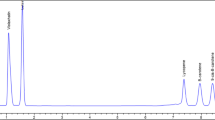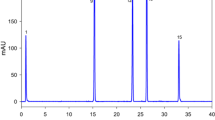Abstract
The ultra high performance liquid chromatography (u-HPLC) method for determination of β-carotene in foods was validated in terms of precision, accuracy, and linearity. The u-HPLC separation was performed on a reversed column C18 (particle size 2 μm, i.d. 2 mm, length 50 mm), followed by ultra violet (UV) detection at 450 nm. The recovery of β-carotene was more than 84.4% and the limit of detection and limit of quantitation of u-HPLC analysis were 0.28 and 0.85 μg/mL for β-carotene with butylated hydroxytoluene (BHT) and 0.62 and 1.89 μg/mL for β-carotene without BHT, respectively. The calibration graph for β-carotene was linear from 0.1 to 25.0 μg/mL for u-HPLC. The intra- and interday precisions (relative standard deviations) were <7.5 and <7.8%, respectively. Benefits of u-HPLC analysis of β-carotene in foods is reduction of the analysis time to approximately 1/4, saving the volume of solvent to approximately 1/15. It seems that u-HPLC can offer significant improvements in speed, sensitivity, and resolution compared with conventional HPLC, this bodes well for future applications.
Similar content being viewed by others
References
Wikipedia, The Free Encyclopedia. Beta-carotene. Available from http://en.wikipedia.org/wiki/beta-Carotene. Accessed Dec. 10, 2009.
Bertram JS. Carotenoids as cancer preventive agents. pp. 307–310. In: Retinoids and Carotenoids in Dermatology. Vahlquist A, Duvic M (eds). Informa Healthcare USA, Inc., New York, NY, USA (2007)
Jialai I, Norkus EP, Cristol L, Grundy SM. Beta-carotene inhibits the oxidative modification of low-density lipoprotein. Biochim. Biophys. Acta 1086: 134–138 (1991)
Sies H, Stahl W, Sundquist AR. Antioxidant functions of vitamins. Vitamins E and C, beta-carotene, and other carotenoids. Ann. NY Acad. Sci. 669: 7–20 (1992)
Mayne ST. Beta-carotene, carotenoids, and disease prevention in humans. FASEB J. 10: 690–701 (1996)
Burton GW, Ingold KU. Beta-carotene: An unusual type of lipid oxidant. Science 224: 569–573 (1984)
Peto R, Doll R, Buckley JD, Sporn MB. Can dietary beta-carotene materially reduce human cancer rates? Nature 290: 201–208 (1981)
Zhao B, Tham SY, Lai MH, Lee LKH, Moochhala SM. Simultaneous determination of vitamin C, E, and β-carotene in human plasma by high-performance liquid chromatography with photodiode-array detection. J. Pharm. Pharm. Sci. 7: 200–204 (2004)
Driskell WJ, Bashor MM, Neese JW. Beta-carotene determined in serum by liquid chromatography with an internal standard. Clin. Chem. 29: 1042–1044 (1983)
Stahl W, Sundquist AR, Hanusch M, Schwarz W, Sies H. Separation of beta-carotene and lycopene geometrical isomers in biological samples. Clin. Chem. 39: 810–814 (1993)
Aaran RK, Nikkari TJ. HPLC method for the simultaneous determination of beta-carotene, retinol, and alpha-tocopherol in serum. J. Pharmaceut. Biomed. 6: 853–857 (1988)
Dietz JM, Kantha SS, Erdman Jr JW. Reversed phase HPLC analysis of α- and β-carotene from selected raw and cooked vegetables. Plant Food Hum. Nutr. 38: 333–341 (1988)
Weissenberg M, Levy A, Schaeffler I, Menagem E, Barzilai M. Rapid isocratic HPLC analysis of beta-carotene in red peppers (Capsicum annuum L.) and food preparations. Chromatographia 46: 399–403 (1997)
Gregory KG, Chen TS, Philip T. Quantitative analysis of carotenoids and carotenoids esters in fruits by HPLC: Red bell peppers. J. Food Sci. 52: 1071–1073 (2006)
Estella-Hermoso de Mendoza A, Campanero MA, Mollinedo F, Blanco-Prieto MJ. Comparative study of A HPLC-MS assay versus an UHPLC-MS/MS for anti-tumoral alkyl lysophospholipid edelfosine determination in both biological samples and in lipid nanoparticulate systems. J. Chromatogr. B 877: 4035–4041 (2009)
Mallett DN, Ramirez-Molina C. The use of partially porous particle columns for the routine, generic analysis of biological samples for pharmacokinetic studies in drug discovery by reversed-phase ultrahigh performance liquid chromatography-tandem mass spectrometry. J. Pharmaceut. Biomed. 49: 100–107 (2009)
Author information
Authors and Affiliations
Corresponding author
Rights and permissions
About this article
Cite this article
Ha, J., Shim, YS., Seo, HY. et al. Rapid method for determination of β-carotene in foods using ultra high performance liquid chromatography. Food Sci Biotechnol 19, 1199–1204 (2010). https://doi.org/10.1007/s10068-010-0171-2
Received:
Revised:
Accepted:
Published:
Issue Date:
DOI: https://doi.org/10.1007/s10068-010-0171-2




